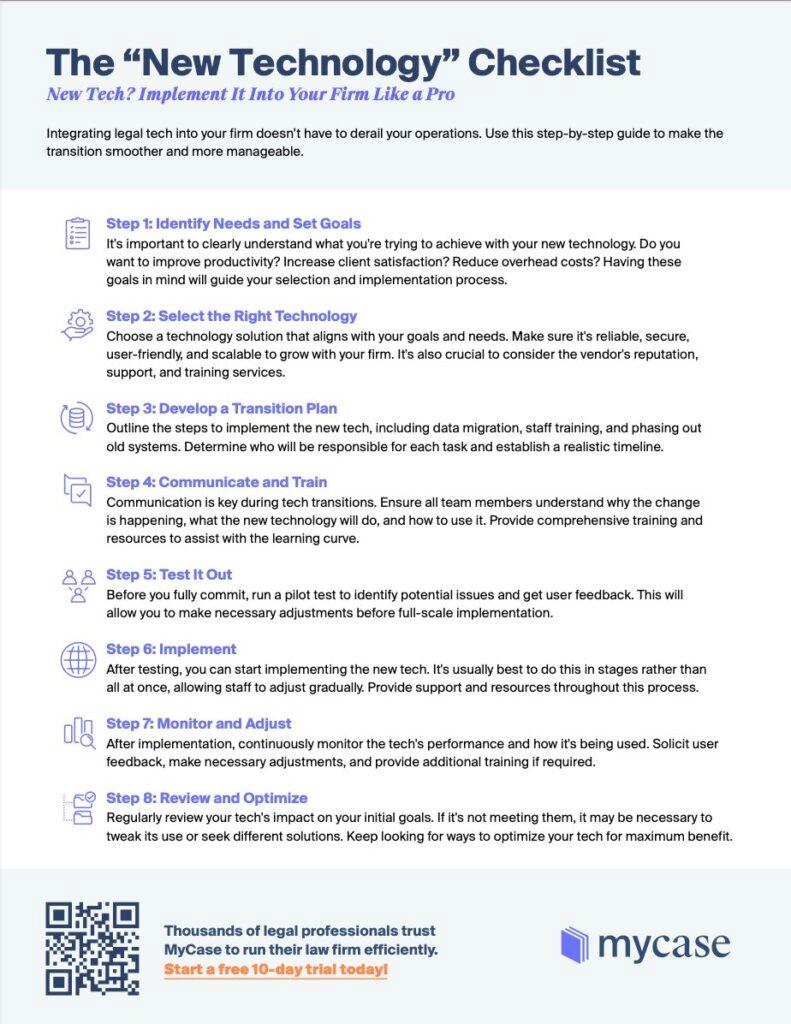Here’s the matter-of-fact truth: The legal landscape increasingly depends on technology. Legal tech solutions have not only become an integral part of efficient law firm operations, but also a significant contributor to firm profitability.
Although the journey to effectively implementing legal tech can seem daunting, jumping on the bandwagon doesn’t have to derail your entire operations. This article will equip you with strategies to overcome common legal tech challenges and navigate toward successful implementation.
Common Legal Tech Barriers

The rapid pace of technological change can make it difficult for legal professionals to keep up. As soon as a firm adopts a new technology, another one appears on the horizon, potentially rendering the first obsolete. This rapid evolution can lead to a sense of “technology fatigue” and contribute to reluctance to adopt new tools. The following are some common legal tech barriers law firms encounter when researching, purchasing, or implementing new technology.
Cost of technology
Data security concerns
Reworking processes to include new tools
Integration issues with other software the firm is already using
Ensuring compliance
Vendor reliability
Evaluating the usefulness and return on investment
While we won’t dive into all of the specific concerns surrounding these friction points in this article, we encourage you to check out our Legal Tech Myth Busting Guide for a more in-depth look at some common legal tech misconceptions.
Strategies for Overcoming Legal Tech Challenges

By applying these strategies, law firms can effectively overcome the common challenges associated with implementing legal tech solutions and harness these technologies’ full benefits.
Address Resistance to Change
Resistance to change is a common challenge in many sectors, including law firms. The strategies below can help alleviate this.
Promote a tech-friendly culture: Make it clear that the firm values technology and sees it as a critical tool for success. This could be demonstrated through ongoing communication, promoting tech-savvy individuals to leadership roles, or recognizing those who embrace and adapt to new technologies.
Involve stakeholders in decision-making: Individuals who feel involved in selecting and implementing new technology are more likely to accept and support it.
Provide adequate training and support: Many individuals resist tech changes because they’re concerned about their ability to use new tools. You can help ease these concerns and smooth the transition by providing comprehensive training and ongoing support.
Stay in the know: Encourage a culture of continuous learning within your firm. This will help you anticipate changes and stay ahead of the curve. At MyCase, our experts regularly share helpful articles, case studies, and webinars covering the latest and most significant trends to help you monitor tech trends and advancements in the legal industry.
Put Your Mind at Ease: Addressing Data Security Concerns
Security is a top concern for law firms due to the sensitive nature of their work. Selecting legal tech solutions that offer strong data security measures, including encryption and regular security audits is crucial.
Even with secure legal technology solutions, taking additional steps to protect your firm is important. This may include:
Regular cybersecurity training for staff
Implementing strong password policies
Routine system audits to identify potential vulnerabilities
Bridge the Knowledge Gap: Addressing the Tech Learning Curve
Providing staff with thorough training on how to use new tech is crucial. This may involve in-person training sessions, online tutorials, or one-on-one coaching. The training should be tailored to suit different learning styles and should be ongoing to cater to new updates and features.
In addition to training, ensure your staff can access technical support when needed. This could be an in-house IT team or support provided by the tech vendor. At the very least, ensure that whatever technology you decide to use has a knowledgeable, friendly, and accessible team of support staff to assist you and your team.
Tackle Cost Concerns
As a good business owner, you probably often look for ways to cut costs. That’s understandable; every business depends on cash.
Frugality and budget management are one thing, but cutting too many corners on legal tech can lead to being penny-wise and pound-foolish, ultimately hurting your business.
The reality is that sometimes you have to spend money to make money. How can you ensure you’re investing in the right legal technology solutions and evaluate whether your tech will generate the value your business needs? Let’s take a look.
Opt for scalable solutions: Choose legal technology solutions that allow you to start small and expand as your needs and budget allow.
Take advantage of free trials: Leverage free trials offered by vendors. This helps assess the tool’s suitability to the firm’s needs and enables you to understand the real benefits and potential issues without any financial commitment.
Ask your peers: Engaging with other law firms or legal professionals who have already adopted the technology of interest can provide real-world reviews on the product’s usefulness, cost-effectiveness, and potential drawbacks.
Only buy what you need: It’s crucial to accurately evaluate your needs and avoid being enticed by non-essential features. By focusing on tools that meet your specific requirements, you can avoid unnecessary costs associated with over-complicated systems.
Showcase Return on Investment (ROI): Demonstrate the return on investment that tech can bring, from improved efficiency to increased client satisfaction. While there’s a cost associated with legal tech implementation, the long-term financial benefits often far outweigh these initial costs. Keep reading to learn our top tips for measuring and evaluating the ROI of your technology investments.
Choose a Technology Partner that Works with Your Firm
Choosing the right partner all comes down to vetting your options. Before committing to a solution, research potential vendors thoroughly. Look at their track record, customer reviews, and how they’ve handled issues in the past. Building a solid relationship with your vendor can lead to better service, quicker response times, and more customized solutions.
Also, consider how new tech will integrate with your existing systems. Some solutions work seamlessly with other common law firm technologies, saving you time and avoiding potential issues down the line.
To avoid breaching any regulations, ensure you understand the compliance requirements specific to your field and how your new tech helps to meet these requirements. To further give you peace of mind, consider using a tech solution built specifically for the legal industry, like MyCase, where regulations are considered in the product’s core functionality—not as an afterthought.
Facilitating Smooth Tech Transitions

Implementing new technology in your law firm need not be a daunting task. A well-planned, step-by-step guide can make the transition smoother and more manageable.
Step 1: Identify Needs and Set Goals
Before you start your transition, it’s important to clearly understand what you’re trying to achieve with your new technology. Do you want to improve productivity? Increase client satisfaction? Reduce overhead costs? Having these goals in mind will guide your selection and legal tech implementation process.
Step 2: Select the Right Technology
Choose a technology solution that aligns with your goals and needs. Make sure it’s reliable, secure, user-friendly, and scalable to grow with your firm. It’s also crucial to consider the vendor’s reputation, support, and training services.
Step 3: Develop a Transition Plan
Outline the steps to implement the new tech, including data migration, staff training, and phasing out old systems. Determine who will be responsible for each task and establish a realistic timeline.
Step 4: Communicate and Train
Communication is key during tech transitions. Ensure all team members understand why the change is happening, what the new technology will do, and how to use it. Provide comprehensive training and resources to assist with the learning curve.
Step 5: Test It Out
Before committing, run a pilot test to identify potential issues and get user feedback. For example, if you’d like to implement new time-tracking software for your attorneys, allow a handful of team members to use the new system for a few days. This will allow you to make necessary adjustments before full-scale implementation.
Step 6: Implement
After testing, you can start implementing the new tech. It’s usually best to do this in stages rather than all at once, allowing staff to adjust gradually. Provide support and resources throughout this process.
Step 7: Monitor and Adjust
After implementation, continuously monitor the tech’s performance. Solicit user feedback, make necessary adjustments, and provide additional training if required.
Step 8: Review and Optimize
Regularly review your tech’s impact on your initial goals. If it’s not meeting them, it may be necessary to tweak its use or seek different solutions. Keep looking for ways to optimize your tech for maximum benefit.
Remember, technology transitions can seem challenging, but with a well-planned and executed strategy, you can significantly mitigate potential disruption and facilitate a smooth transition. Refer to the checklist below for a quick reference guide to ensure a stress-free adoption process.

Measuring Success and Continuous Improvement
As law firms increasingly integrate technology into their daily operations, measuring these tools’ success and committing to continuous improvement is imperative. The rapid pace of technological advancement means that merely adopting a tool isn’t enough; firms must actively gauge these technologies’ effectiveness and strive for optimal usage.
Identify Key Performance Indicators (KPIs): First, determine what success looks like for the technology tool. This could involve several key performance indicators (KPIs), such as time saved, increased case throughput, decreased errors, improved client satisfaction, etc. Each tool may have a unique set of KPIs relevant to its purpose and use cases.
Establish Baselines: Before legal tech implementation, establish baselines for each KPI identified in step one. These baselines will provide a point of reference to measure the impact of the technology tool. For instance, how long did it take to manage your manual invoicing process in the past compared to after implementing invoicing software?
Monitor and Measure: After implementing the technology, monitor and measure the KPIs against the baselines. This could be done weekly, monthly, or quarterly, depending on what makes the most sense for the KPI and the tool.
Analyze the Results: Examine the data to identify trends, improvements, and areas where performance may lag. Consider both quantitative and qualitative data for a complete picture.
Make Adjustments: If the tool is not meeting its intended KPIs or user feedback indicates issues, make adjustments. This could mean changing how you use the tool, providing additional user training, or working with the vendor to troubleshoot problems.
Implement Changes and Document: Once you decide on adjustments, they should be implemented as quickly as feasible. Document any changes to processes, policies, or procedures to ensure all users understand the new expectations.
Review and Iterate: Continuous improvement involves constantly reviewing the process and results, then making further refinements as needed. Ideally, this cyclical process monitors performance, makes changes, and evaluates the results.
Celebrate Success: When you see improvements or the tool achieves its intended KPIs, celebrate these successes. This can help promote buy-in from all users and foster a culture open to change and continuous improvement.
The MyCase Solution: Expert Onboarding and Support Services
At MyCase, we assist law firms in implementing legal technology smoothly.
Our personalized support, comprehensive training, and intelligent tools are all part of our unique approach. We offer a tailored onboarding program, considering each law firm’s individual requirements and workflows. Our specialists collaborate directly with you, devising the most effective way to harness MyCase’s software power and ease the transition into the new system.
To overcome the challenges of user adaptation, we provide extensive training to your law firm staff. This includes practical tutorials, informative webinars, and resource materials that empower your team to fully leverage the new system. Our support team is well-equipped to address any technical issues promptly, allowing you to concentrate on your legal work rather than tech complications.
We also offer resources like our “Guide To Switching Law Practice Management Software,” a roadmap for a smooth transition to a new legal practice management system. This guide lays out key tips and considerations for law firms at every stage of the switch, ensuring a trouble-free adoption of the new technology.
Final Thoughts
Implementing legal tech in your law firm can seem challenging, but with the right strategies, you can navigate these challenges successfully. Utilize the tips and techniques outlined in this blog post to make the most of legal tech in your law firm.
Additionally, remember to try MyCase (you can take advantage of a free 10-day trial) and ask about how our support services can enable you to overcome any hurdles along your legal tech journey. We’re here to help you streamline and automate operations so you can focus on what matters most: practicing law.
About the author

Hannah DeFreitasSenior Content Writer
Hannah DeFreitas is a Senior Content Writer for leading legal software brands, including MyCase, Docketwise, CASEpeer, and LawPay—the #1 legal payment processor. She distills industry trends and data into strategic insights that empower legal professionals to streamline workflows, increase revenue, and gain a competitive edge.
